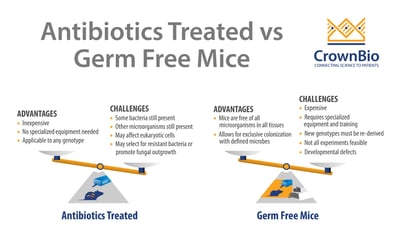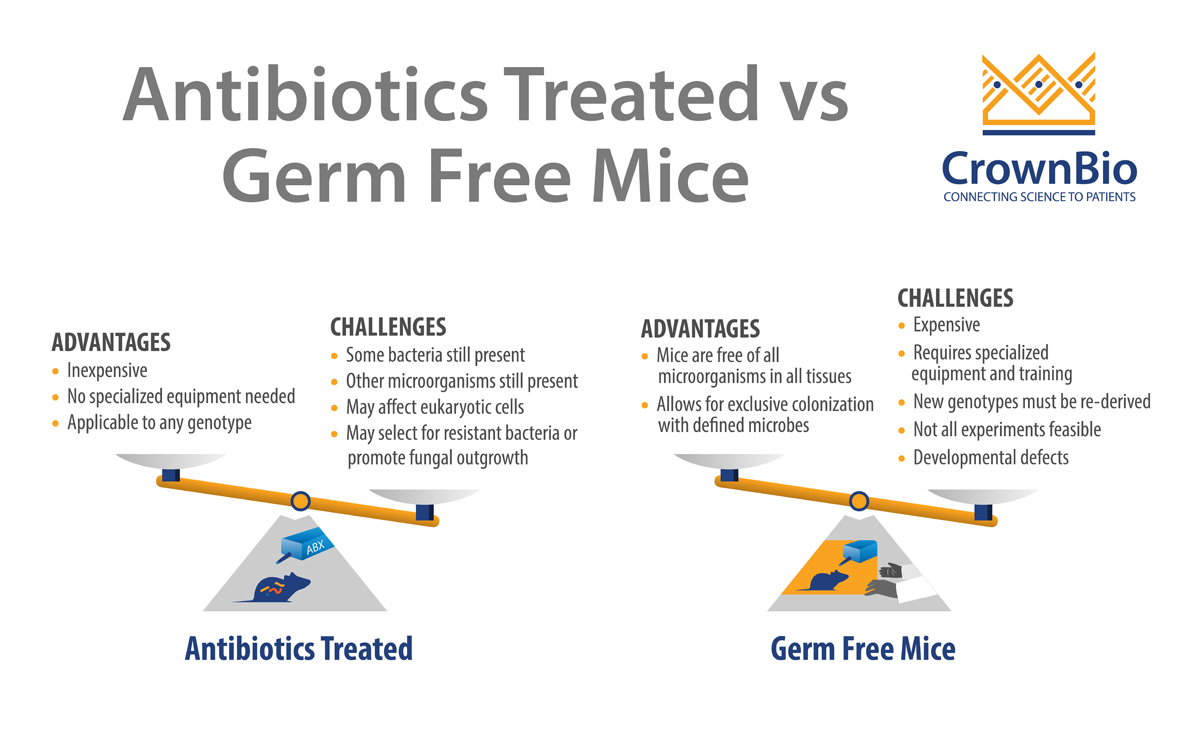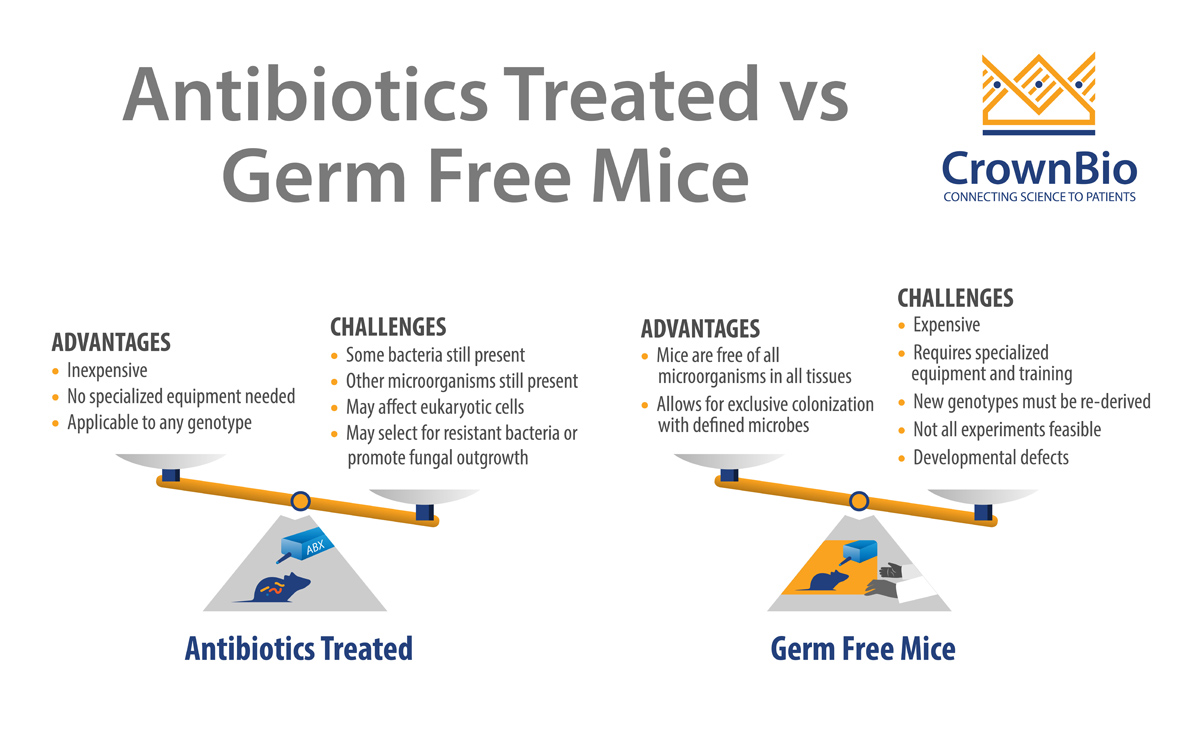 Explore the differences and similarities of germ-free (GF) and antibiotic-treated mice as models for studying the role of the microbiota in health and disease, including cancer.
Explore the differences and similarities of germ-free (GF) and antibiotic-treated mice as models for studying the role of the microbiota in health and disease, including cancer.
The Expanded Use of Germ-Free and Antibiotic-Treated Mice
The use of germ-free and antibiotic-treated mouse models has increased dramatically in recent years due to the increasing evidence showing that the microbiota (collectively consisting of the bacteria, viruses, fungi, and archaea that inhabit different niches in the body) plays a significant role in determining health and disease, including normal and pathologic immune responses to cancer; in both patients and animal models.
Overall, the immune response may be an important link that connects the gut microbiota and cancer. Indeed, data from several cancer immunotherapy studies have sparked the interest and effort of researchers to better understand how the microbiota composition may improve the outcome of cancer therapeutics, including immunotherapies.
The Intersection of the Microbiota and Cancer Drugs
Traditionally, anticancer drugs have been developed as cytotoxic agents that directly kill cancer cells. However, there has been a major paradigm shift over recent years given that the immune system has been shown to play a major role in the development and treatment of cancer. There is also a growing body of evidence showing that the microbiota plays an important role in shaping systemic immune response.
Several studies (preclinical and clinical) have demonstrated that the gut microbiota directly promotes antitumor immunity and enhances the efficacy of checkpoint inhibitors, such as anti-CTLA-4 and anti-PD-L1 targeting antibodies. Oral antibiotics have also been shown to act as immunotherapeutic agents in mice, synergizing with checkpoint inhibitors.
There are also data suggesting that the endogenous microbiota moves beyond the gut to other organs and can modulate the progression of cancer. This includes one such study that showed the microbiota affected the progression of pancreatic cancer and targeting the microbiota enhanced the efficacy of immunotherapy.
To study the immunomodulatory role of microbiota on immunotherapies in preclinical studies, researchers rely on mice that lack a gut microbiota which can then be repopulated with defined microbes or via fecal transplantation. There are two major options when it comes to selecting a mouse model lacking a gut microbiota:
- Germ-Free Mice
- Antibiotic-Treated Mice
The two models have some important differences and similarities that should be considered prior to choosing a model for your preclinical studies. The following sections highlight some of the key strengths and weaknesses of these two models.
Germ-Free Mice
GF mice are raised in isolators so they are never exposed to microorganisms and therefore completely free from microbes. GF mice are considered the gold-standard model for mice lacking a microbiota, and they allow for study designs that require the complete absence of microbes and for generating gnotobiotic mice that are colonized by defined microbes. GF mice tend to be readily available for commonly used strains of mice, but if a unique strain is needed, then they must be rederived in an isolator facility.
Some of the prominent strengths and weaknesses of GF mice include:
Strengths
- Animals are completely free of all microbes
- Allow for generation of gnotobiotic animals via colonization with defined microbes
Weaknesses
- Relatively expensive as compared to antibiotic-treated animals
- Requires specialized facilities, equipment, and trained personnel for maintenance of the colony and continual monitoring for contamination
- New genetic strains must be re-derived to achieve GF status
- GF animals are not feasible for all experiments and maintenance in isolators can make some studies challenging
- Some data suggest there are some developmental defects in GF mice
Antibiotic-Treated Mice
Treating mice with antibiotics is another method to eliminate the microbiota and there are some key differences from GF mice. In general, antibiotics can be used to selectively deplete different components of the microbiota—this is not the case for GF mice that are completely devoid of all microbes—which can be achieved using antibiotics having different affinities for different microbes. The antibiotic treatment method also allows researchers to generate models with varying levels of microbiota depletion.
For instance, single antibiotics can be used to “shift” the composition of the gut microbiota, whereas the use of an antibiotic cocktail can be used to deplete the complete gut microbiota. Lastly, antibiotic-treatment can be done using any strain of mouse without having to re-derive the animals as is the case for GF mice.
Some of the prominent strengths and weaknesses of antibiotic-treated mice include:
Strengths
- Inexpensive and highly accessible
- Does not require specialized equipment
- Applicable to any genotype (re-derivation is not required)
- Can be used for experiments where the microbiota is eradicated after birth
Weaknesses
- Complete eradication of the microbiota may not be possible, and some microbes may still be present (this can vary from experiment to experiment, or across laboratories)
- Off-target effects of antibiotics may occur
- Possible acquisition of antibiotic-resistant bacteria and outgrowth of fungal species
- The precise dosage of treatment can be challenging to control
- No standardized antibiotic treatment regimens
Conclusion
Germ-free and antibiotic-treated mice represent two types of approaches that are used to generate models for studying the contributions of the microbiota in preclinical oncology studies, including the study of immunotherapies.
While GF mice are commonly considered the gold-standard for studying host-microbe and microbe-microbe interactions, the antibiotic-treatment approach is an economical and accessible alternative. Prior to selecting a model for your study, it is key to understand the strengths and limitations of these models. This will maximize the chances that the optimal model will be selected for your specific research needs.






